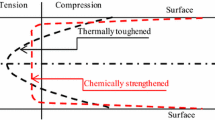Abstract
Acetylated OSB stakes were tested in ground contact in Western Greece. Two levels of acetylation were used, a high and a low level of 20.4% and 11.2% acetyl content, respectively. The highly acetylated stakes showed severe attack after 96 months and total decay after 102 months of testing.
Similar content being viewed by others
1 Introduction
Chemical modification has been used to improve decay resistance of both wood and wood based panels. The majority of researches investigating this area has been concerned with the reaction of acetic anhydride since it is well documented that acetylation imparts excellent protection against decay. The purpose of this paper was to report on the performance of acetylated OSB in ground stake test.
2 Experimental
The acetylation of fir strands (Picea abies), the laboratory manufacture of OSB and the ground stake test is described in detail in a previous paper (Papadopoulos 2006).
3 Results and discussion
It was reported earlier (Papadopoulos 2006, 2009) that the control stakes were totally decayed after four years and the low-acetylated stakes after six years of testing. On the other hand, the high-acetylated stakes showed moderate decay (upper part of Table 1). The lower part of the Table presents the new data. It can be seen that the high-acetylated stakes showed severe decay after 96 months and total decay after 102 months in ground stake test.
References
Papadopoulos AN (2006) Decay resistance of acetylated OSB in ground stake test. Holz Roh- Werkst 64:245–246
Papadopoulos AN (2009) Decay resistance in ground stake test of acetylated OSB in ground stake test. Eur J Wood Prod 67:365–366
Author information
Authors and Affiliations
Corresponding author
Rights and permissions
About this article
Cite this article
Papadopoulos, A.N. Natural durability of acetylated OSB in ground stake test: total decay after 102 months of testing. Eur. J. Wood Prod. 70, 397 (2012). https://doi.org/10.1007/s00107-011-0547-x
Received:
Published:
Issue Date:
DOI: https://doi.org/10.1007/s00107-011-0547-x




